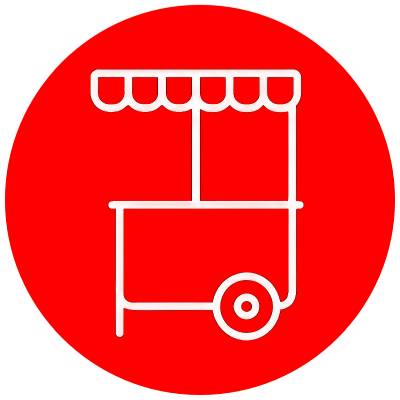ADVISORY: DEPARTMENT OF LICENSING AND CONSUMER PROTECTION ISSUES BUSINESS ADVISORY REGARDING TOWING RELATED TO HEAVY-DUTY TOWING
Tow Truck Fee Guidelines for Food Trucks
To deter illegal parking of large vehicles including food trucks, the District of Columbia Municipal Regulations (DCMR) allow for escalated fees when those vehicles must be towed. Those regulations can be found and read specifically in chapter 4 of Title 16 of the District of Columbia Municipal Regulations (DCMR).
Section 16-408 of the DCMR defines the charges related to public tows in the District of Columbia. Vehicles with a Gross Vehicle Weight over 8,000 pounds are considered “heavy duty tows”. See 16 DCMR § 408.(c). Tow trucks have a Gross Vehicle Weight in excess of 8,000 pounds, and thus, fall within this category. The fees for the towing of these vehicles are set forth in 16 DCMR § 1408.1, and are as follows:
- $275.00 for preparation, hoist, and tow to a location in the District (Roll-back or wheel lift – use of dollies included)
- $3.00 for towing charge per mile for each mile beyond the District line (at the owner’s request); and
- $20.00 for storage, per 24-hour period, or part thereof
In addition to the charges above, the 16 DCMR § 408.3 allows a licensed towing businesses to “collect extra charges on-site for the use of cranes, winches, dollies, or other equipment or services to perform a public tow under extraordinary circumstances or the restoration or cleaning of an accident site”.[1] These extra charges, once collected, must be submitted to the Director of the Department of Licensing and Consumer Protection (DLCP) within 72 hours of collection, along with documentary evidence of the extraordinary circumstances and a request for the Director’s approval.[2] Approval is at the discretion of the Director.[3] If the Director does not approve the extra charges, the towing business must provide a refund to the customer in the amount of the disapproved charges within 72 hours of receipt of the Director’s notice of disapproval.
Considerations that may qualify as extraordinary circumstances to justify increased fees include but are not limited to:
- Necessary Use of Special Equipment, including but not limited to:
- Wheel Dollies: Wheel dollies are devices that can be attached to the wheels of a vehicle to allow it to roll freely, even if the transmission is in park. This is useful for towing vehicles with locked wheels or those that cannot be towed with all wheels on the ground.
- Winches: Tow trucks are equipped with winches, which are motorized cable systems used to pull vehicles onto the tow truck bed. Winches are especially useful in situations where a vehicle is unable to move on its own, such as when stuck in mud or positioned in a tight space.
- Winch Line Extensions: In situations where a tow truck needs to access a vehicle in a challenging location, winch line extensions can be used to reach the target.
- Flatbeds or Rollback Trucks: Flatbed tow trucks, also known as rollback trucks, have a flat, open bed that can be tilted to the groun This design allows for easy loading and unloading of vehicles, making them suitable for towing cars, trucks, and other vehicles, especially those with low ground clearance.
- Wreckers: Wreckers are tow trucks equipped with a lifting mechanism, often with a boom and a hook or a wheel lift, used to hoist the front or rear of a vehicle off the ground. Wreckers are versatile and can handle various towing scenarios, including recovery from ditches or tight spaces.
- Chains and Straps: Tow truck operators use heavy-duty chains and straps to secure vehicles during towing. Properly securing the vehicle is crucial for safety and to prevent damage during transit.
- Rotators: Rotator tow trucks have a rotating crane-like apparatus that can lift and rotate heavy loads. These trucks are often used in complex recovery operations, such as overturns or large vehicle extractions.
- Dollies for flat tires: Tow operators may use dollies designed for flat tires to support and tow vehicles with one or more flat tires.
- Air Cushions: Air cushions are inflatable devices placed under a vehicle to lift it off the ground. They are especially useful in situations where a vehicle is overturned or in a difficult position, and traditional lifting methods may not be suitable.
- Tire Lifts and Straps: These devices are used to lift and secure a vehicle by its tires, allowing for towing without putting stress on the chassis or body of the vehicle. This can be beneficial for towing vehicles with low ground clearance, including heavy vehicles with flat tires.
- Go-Jaks: Go-Jaks are portable, multi-directional dolly systems that allow tow truck operators to move a vehicle laterally without the need to tow it conventionally. They are handy in tight spaces or situations where turning the vehicle is challenging.
- Snatch Blocks: Snatch blocks are pulley systems used in conjunction with winches to change the direction of the pulling force. They are useful for recovery operations, especially when a straight-line pull is not feasible.
- Spreader Bars: Spreader bars are used in conjunction with chains or straps to provide additional stability when towing larger or wider vehicles. They help distribute the weight and prevent damage during the towing process.
- Light Towers: Tow trucks may be equipped with light towers to illuminate the towing area, especially in low-light conditions or during nighttime recoveries.
- Jaws of Life: While primarily associated with emergency response vehicles, some tow trucks may be equipped with hydraulic rescue tools, such as the Jaws of Life, for extricating individuals from vehicles involved in accidents.
- Drip Pans and Absorbent Materials: Tow trucks may carry drip pans and absorbent materials to contain and clean up spills, especially in cases where the towed vehicle has fluid leaks, such as cooking oil.
- Tight spaces. A large vehicle parked in a tight space can make it challenging to maneuver a tow truck into position for towing. Narrow streets, confined parking lots, or areas with obstacles, such as densely parked trucks, can complicate the towing process. In such cases, a skilled tow truck operator may need to navigate carefully to avoid damage to the food truck or surrounding vehicles.
- Obstacles and Terrain. Uneven terrain, curbs, fire hydrants, or other obstacles in and adjacent to the towing path can pose challenges to the tow truck operator. The tow truck operator must assess the surroundings to determine the best approach and ensure a smooth towing process without causing damage to the food truck or the tow truck itself.
- Cooking Oils and Grease. Food trucks often use cooking oils and produce grease as part of their operations. Over time, these oils can accumulate on the exterior and undercarriage of the food truck. Tow truck operators should be cautious of slippery surfaces and take precautions to avoid any slips or falls during the towing process.
- Safety Precautions. To mitigate risks associated with cooking oils and potential rodent issues, tow truck operators should wear appropriate personal protective equipment (PPE), such as gloves, and take steps to secure loose items on and around the food truck. This includes ensuring that any cooking equipment or items that could pose a safety hazard are properly secured before towing.
- Rodent Infestations. If a food truck has been stationary for an extended period, there is an increased risk of attracting rodents and pests. Towing operators should be aware of the potential presence of rodents in and around the food truck. Before towing, it may be advisable to inspect the truck for signs of infestations and take appropriate measures to ensure the safety and cleanliness of the towing process.
If you are a towing company and would like to submit justification of increased fees for extraordinary circumstances, please direct your justification to [email protected]. Failure to request justification after 72 hours of collection of payment will automatically result in a denial of a request for additional fees and tow companies will be required to refund any amount over the standard towing fee.
It is imperative that tow truck companies follow the procedures outlined above. Failure of a towing company to comply with District laws may result in the issuance of a Notice of Infraction. A violation of the towing laws carries a fine of $2,358 per violation for the first offense. A second offense can result in a fine of $4,715 per violation, a third offense $9,413 per violation, and fourth or subsequent offense can result in a fine of $18,862 per violation.
If you would like to file a complaint against a towing company, you may submit your complaint to DLCP here or emailing dlcp.dc.gov.








